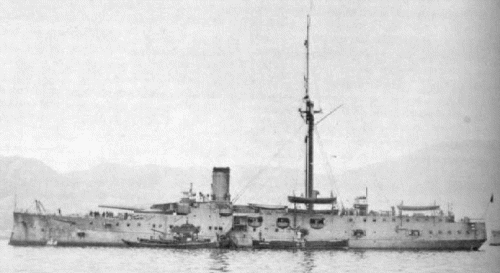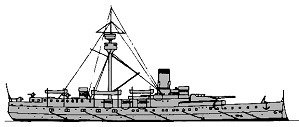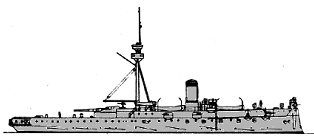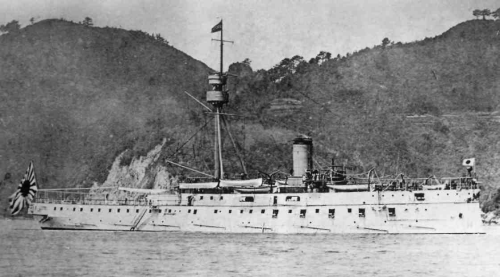
NAVYPEDIA
 Support the project with paypal
Support the project with paypal
Photo

Hashidate 1908
Ships
| Name | No | Yard No | Builder | Laid down | Launched | Comp | Fate |
|---|---|---|---|---|---|---|---|
| 橋立 [Hashidate] | Yokosuka K K | 6.8.1888 | 24.3.1891 | 26.6.1894 | TS 1906, stricken 12.1925 | ||
| 厳島 [Itsukushima] | F C de la Méditerranée, La Seyne, France | 7.1.1888 | 18.7.1889 | 3.9.1891 | TS 1906, submarine tender 1919 | ||
| 松島 [Matsushima] | F C de la Méditerranée, La Seyne, France | 17.2.1888 | 22.1.1890 | 5.4.1892 | TS 1906, internal explosion 30.4.1908 |
Technical data
| Displacement normal, t | 4217 |
|---|---|
| Displacement full, t | |
| Length, m | 91.8 wl 99.8 oa |
| Breadth, m | 15.4 |
| Draught, m | 6.04 |
| No of shafts | 2 |
| Machinery | 2 HTE, 6 cylindrical boilers |
| Power, h. p. | 5400 |
| Max speed, kts | 16.5 |
| Fuel, t | coal 680 |
| Endurance, nm(kts) | 5500(10) |
| Armour, mm | Harvey steel - barbette: 300, turret: 100, shields: 110, deck: 40, machinery glacis: 50, CT: 125 - 35 |
| Armament | Matsushima: 1 x 1 - 320/38 M1887, 12 x 1 - 120/40 Armstrong R, 6 x 1 - 57/40 6pdr Hotchkiss Mk I, 11 x 1 - 37/20 1pdr Hotchkiss Mk I, 4 - 350 TT (1 bow, 1 stern, 2 beam) Itsukushima: 1 x 1 - 320/38 M1887, 11 x 1 - 120/40 Armstrong R, 5 x 1 - 57/40 6pdr Hotchkiss Mk I, 12 x 1 - 37/20 1pdr Hotchkiss Mk I, 4 - 350 TT (1 bow, 1 stern, 2 beam) Hashidate: 1 x 1 - 320/38 M1887, 11 x 1 - 120/40 Armstrong R, 6 x 1 - 57/40 6pdr Hotckiss Mk I, 11 x 1 - 37/20 1pdr Hotchkiss Mk I, 4 - 350 TT (1 bow, 1 stern, 2 beam) |
| Complement | 360 |
Standard scale images

Hashidate 1894

Matsushima 1891
Graphics
Project history
The deteriorating situation between Japan and China made it essential for Japan to acquire ships capable of matching the Chinese fleet. Japan had not, at that time, sufficient expertise or training to build and man large battleships and so turned to the French constructor, Émile Bertin, for assistance. The request was for protected cruisers armed with a large gun capable of penetrating the armour on the Chinese battleships. One of the most powerful guns available at the time was the Canet 320mm, and this was duly fitted in the ships. The guns had a slow rate of fire of one round every five minutes, and at the Battle of the Yalu proved all but useless.
The design was not a success, the stipulated displacement being too low to mount such heavy armament. Consequently protection was to a large extent sacrificed, except around the heavy gun, and the ships were extremely vulnerable to any shells larger than 120mm. In addition seaworthiness was poor and the designed speed was never achieved.
Matsushima carried her gun aft with the secondary armament forward, while Itsukushima carried the 320mm gun forward and the secondary armament aft. Hashidate was identical to Itsukushima, except that her 57mm guns were in unarmoured sponsons to give an increased arc of fire.
Ship protection
Hull was protected by only 38mm deck with 38mm slopes, machinery had 51mm glacis. Main gun had 300mm barbette and 100mm turret, 120mm guns had 110mm shields, CT sides were protected by 100mm armour on 25mm plating and roof by 25mm armour on 10mm plating. Shell hoist of main gun had 250mm protection.
Modernizations
1901 - 1902, Matsushima, Itsukushima: boilers were replaced by 8 Belleville
1901 - 1902, Hashidate: boilers were replaced by 8 Miyabara.
Naval service
Hashidate served as TS from 1906, stricken in 1923 but used as training hulk until 1927. Itsukushima was damaged 2.9.1894 by 8 shell hits from Chinese ships, later repaired. She became TS in 1906, stricken 1919 but used as submarine tender until 1922. Matsushima also was used as TS from 1906. She was lost 30.4.1908 by a magazine explosion in Mako Harbour in the Pescadores, 141 dead.
 HOME
HOME FIGHTING SHIPS OF THE WORLD
FIGHTING SHIPS OF THE WORLD JAPAN
JAPAN CRUISERS
CRUISERS MATSUSHIMA protected cruisers (1891 - 1894)
MATSUSHIMA protected cruisers (1891 - 1894)

